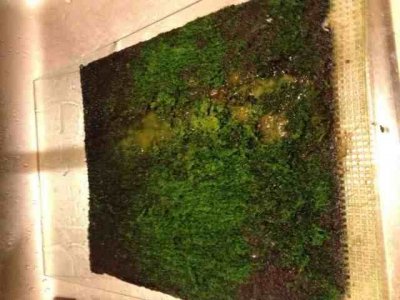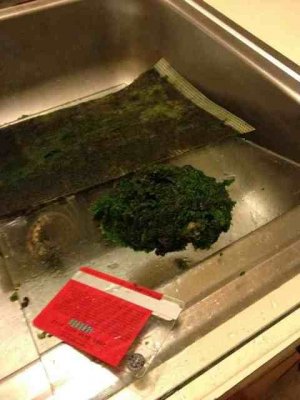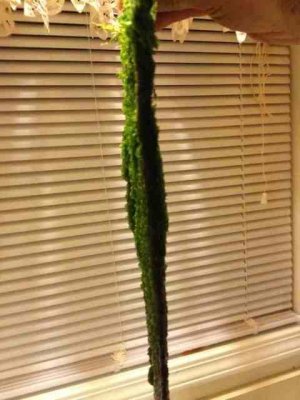You are using an out of date browser. It may not display this or other websites correctly.
You should upgrade or use an alternative browser.
You should upgrade or use an alternative browser.
Algae Scrubber Basics
- Thread starter srusso
- Start date
looking for some advice.
I was considering buying an LED grow light from E bay.
here are the specs.
Power Supply AC110V 12W
Output Voltage 36V
Frequency 50-60Hz
LED Qty 168pcs
Color Red and Blue
Lumen(Red/Blue) Red: 6.6Lux x 138 LEDs
Blue: 1.8Lux x 30 LEDs
Wavelength Red: 660nm
Blue: 450nm
LEDs Diameter 5mm
Each Light Size 5" diameter x 5" deep
do you guys think this lamp will work well for ATS?
does this light have the correct spectrum, red:blue ratio, and enough power to work ?
thanks
Dan
I was considering buying an LED grow light from E bay.
here are the specs.
Power Supply AC110V 12W
Output Voltage 36V
Frequency 50-60Hz
LED Qty 168pcs
Color Red and Blue
Lumen(Red/Blue) Red: 6.6Lux x 138 LEDs
Blue: 1.8Lux x 30 LEDs
Wavelength Red: 660nm
Blue: 450nm
LEDs Diameter 5mm
Each Light Size 5" diameter x 5" deep
do you guys think this lamp will work well for ATS?
does this light have the correct spectrum, red:blue ratio, and enough power to work ?
thanks
Dan
Floyd R Turbo
Either busy or sleeping
Step1han3ie that is one weird looking scrubber
Floyd R Turbo
Either busy or sleeping
looking for some advice.
I was considering buying an LED grow light from E bay.
here are the specs.
Power Supply AC110V 12W
Output Voltage 36V
Frequency 50-60Hz
LED Qty 168pcs
Color Red and Blue
Lumen(Red/Blue) Red: 6.6Lux x 138 LEDs
Blue: 1.8Lux x 30 LEDs
Wavelength Red: 660nm
Blue: 450nm
LEDs Diameter 5mm
Each Light Size 5" diameter x 5" deep
do you guys think this lamp will work well for ATS?
does this light have the correct spectrum, red:blue ratio, and enough power to work ?
thanks
Dan
Can you post a pic of this light? I think I know the one you are referring to, with is being 12W and 168 LED those are low power LEDs and it is still questionable whether these will work or not. But these large-array low-power LED lamps are popping up all over the place now. I think people figured out that the smaller (fewer LEDs) versions of these just were worthless, and more is better. It still likely will only cover an area equal to 2x the wattage, given that you use one per side. Meaning 2x 12W = 24W or 48 sq in of overall screen area LxW, which is about 7x7. And IMO that is pushing it. I would stick to 6x6, or even 5x5 because it's LP LEDs and you would probably get excellent growth.
Floyd R Turbo
Either busy or sleeping
He's talking about a UAS, not a waterfall.
Can you post a pic of this light? I think I know the one you are referring to, with is being 12W and 168 LED those are low power LEDs and it is still questionable whether these will work or not. But these large-array low-power LED lamps are popping up all over the place now. I think people figured out that the smaller (fewer LEDs) versions of these just were worthless, and more is better. It still likely will only cover an area equal to 2x the wattage, given that you use one per side. Meaning 2x 12W = 24W or 48 sq in of overall screen area LxW, which is about 7x7. And IMO that is pushing it. I would stick to 6x6, or even 5x5 because it's LP LEDs and you would probably get excellent growth.
I attached a pic of the light. they make lamps that contain 3 watt X 12 LED's,would that that better suited? the higher watted lights seem like they would provide more of a directed spot light then an overall diffused light
thanks
http://www.ebay.ca/itm/965Lux-12W-1...290?pt=LH_DefaultDomain_0&hash=item20ce71ba8a
SantaMonica
Well-known member
Anyones got a design for UAS in which its easier to remove and fix the screen everytime? all the designs i came across are wierd and everytime u get your hands dirty and have trouble fixing the screen back again.
Just extend the screen (or a handle) up above the water, and use it to pull the screen out.
Floyd R Turbo
Either busy or sleeping
I attached a pic of the light. they make lamps that contain 3 watt X 12 LED's,would that that better suited? the higher watted lights seem like they would provide more of a directed spot light then an overall diffused light
thanks
http://www.ebay.ca/itm/965Lux-12W-1...290?pt=LH_DefaultDomain_0&hash=item20ce71ba8a
Yep that is the one I was referring to. That one might actually stand a chance of working, since it's large
srusso
Active member
My harvests have been off the charts since I've been working to maintain potassium levels. Thick, green, massive amounts - my lawn would look great if I could replant it in my yard. Can't say for certain potassium is 100% the reason, or in combination with dialing my lighting in, but there is definitely a significant improvement.
So far, tests indicate potassium level drops 100ppm in 10 days on my 240gl system, feeding 50grams/day with 288sqin of ATS if I don't dose. But that is early results, so don't base any decisions off of it.
I ran out of Brightwell, have been using a plain potassium chloride solution in the ATO for past 30 days. So far so good but I am watching closely.
How is that potassium sulfate working out for you?
Do you think we should move this potassium discussion over to the advanced thread, not complicate it for people who are simply researching or trying to get up & running?
Agreed, my test of potassium after blindly dosing shows levels off the charts last time I tested. I didn't get the same coloration in my corals but I have to agree potassium chloride does still help algae growth.
Going to be doing some large water changes to clear out any imbalances I created by dosing without testing.
Yes, let's take this over to the advanced thread.
(Last weeks harvest)
View attachment 216795


Attachments
Garfield90
New member
Guys, forgive me if I'm wrong, but I'm doing my scrubber's maths and I'm kind of confused.
I have guessed I'm going to feed the fishes like 40 cubes of frozen food (including food, nori and coral food also). If I need 12 sq inches per cube, I'm gonna build a 480 sq inches for my scrubber, right?
And that's a scrubber of 24x20 inches, and 240 led's watts, 120 on each side, right?
Thank you very much for your help
I have guessed I'm going to feed the fishes like 40 cubes of frozen food (including food, nori and coral food also). If I need 12 sq inches per cube, I'm gonna build a 480 sq inches for my scrubber, right?
And that's a scrubber of 24x20 inches, and 240 led's watts, 120 on each side, right?
Thank you very much for your help
Floyd R Turbo
Either busy or sleeping
First of all, Wow. That a lot of feeding.
Second, yes, you are correct on the math. Remember that a "cube" refers to the size of a cube of food from one of those Ocean Nutrition cube trays, or something similar to it. Those are roughly 2-3 cubic centimeters.
Powered and/or liquid coral food is high potency food so it's going to add a lot of load.
All that said in a system like this with so much feeding, I would say that multiple screens with and alternating cleaning schedule is definitely in order. Use good quality LEDs. Do a mixture of 660 reds and 440-450 blues in a 6:1 or 8:1 ratio, and if you can put the blues on a separate driver and dim them a bit, that would be preferable (use more blues also to get better coverage if you dim them). You can throw in a violet or two also.
Second, yes, you are correct on the math. Remember that a "cube" refers to the size of a cube of food from one of those Ocean Nutrition cube trays, or something similar to it. Those are roughly 2-3 cubic centimeters.
Powered and/or liquid coral food is high potency food so it's going to add a lot of load.
All that said in a system like this with so much feeding, I would say that multiple screens with and alternating cleaning schedule is definitely in order. Use good quality LEDs. Do a mixture of 660 reds and 440-450 blues in a 6:1 or 8:1 ratio, and if you can put the blues on a separate driver and dim them a bit, that would be preferable (use more blues also to get better coverage if you dim them). You can throw in a violet or two also.
Floyd R Turbo
Either busy or sleeping
First of all, Wow. That a lot of feeding.
Second, yes, you are correct on the math. Remember that a "cube" refers to the size of a cube of food from one of those Ocean Nutrition cube trays, or something similar to it. Those are roughly 2-3 cubic centimeters.
Powered and/or liquid coral food is high potency food so it's going to add a lot of load.
All that said in a system like this with so much feeding, I would say that multiple screens with and alternating cleaning schedule is definitely in order. Use good quality LEDs. Do a mixture of 660 reds and 440-450 blues in a 6:1 or 8:1 ratio, and if you can put the blues on a separate driver and dim them a bit, that would be preferable (use more blues also to get better coverage if you dim them). You can throw in a violet or two also.
Second, yes, you are correct on the math. Remember that a "cube" refers to the size of a cube of food from one of those Ocean Nutrition cube trays, or something similar to it. Those are roughly 2-3 cubic centimeters.
Powered and/or liquid coral food is high potency food so it's going to add a lot of load.
All that said in a system like this with so much feeding, I would say that multiple screens with and alternating cleaning schedule is definitely in order. Use good quality LEDs. Do a mixture of 660 reds and 440-450 blues in a 6:1 or 8:1 ratio, and if you can put the blues on a separate driver and dim them a bit, that would be preferable (use more blues also to get better coverage if you dim them). You can throw in a violet or two also.
Garfield90
New member
First of all, Wow. That a lot of feeding.
Second, yes, you are correct on the math. Remember that a "cube" refers to the size of a cube of food from one of those Ocean Nutrition cube trays, or something similar to it. Those are roughly 2-3 cubic centimeters.
Powered and/or liquid coral food is high potency food so it's going to add a lot of load.
All that said in a system like this with so much feeding, I would say that multiple screens with and alternating cleaning schedule is definitely in order. Use good quality LEDs. Do a mixture of 660 reds and 440-450 blues in a 6:1 or 8:1 ratio, and if you can put the blues on a separate driver and dim them a bit, that would be preferable (use more blues also to get better coverage if you dim them). You can throw in a violet or two also.
Thank you Floyd. That's, indeed, a lot of feeding, but it's going to be a 800 gallon tank, whole system 1300 gallons, it's not that much haha
I have plenty of space, the sump is 43x39x23" (aprox.) and have more than 16.5" to set up the scrubber. Do you still think I need to have multiple scrubbers??
And, regarding to leds, better 1W ones, right??
Floyd R Turbo
Either busy or sleeping
I would go with 3W LEDs. 1W means you will need 3x as many meaning that much more soldering, and the development as far as output and spectral selection is in 3W, not 1W. 1W now is the same as 1W a year ago. 3W LEDs have continued to improve.
Yes I would do multiple sections most definitely because of the amount of feeding, you want to always have a screen at mid-growth stage when you pull another off to clean it. This is also a case where I would argue that you need multiple forms of filtration. Putting all your eggs in one basket with a 1300g system would be a very bad idea. IMO.
Yes I would do multiple sections most definitely because of the amount of feeding, you want to always have a screen at mid-growth stage when you pull another off to clean it. This is also a case where I would argue that you need multiple forms of filtration. Putting all your eggs in one basket with a 1300g system would be a very bad idea. IMO.
JohnnyB in SD
New member
+++++ What Floyd said about multiple screens & forms of filtration for a system & load like yours.
Garfield90
New member
I would go with 3W LEDs. 1W means you will need 3x as many meaning that much more soldering, and the development as far as output and spectral selection is in 3W, not 1W. 1W now is the same as 1W a year ago. 3W LEDs have continued to improve.
Yes I would do multiple sections most definitely because of the amount of feeding, you want to always have a screen at mid-growth stage when you pull another off to clean it. This is also a case where I would argue that you need multiple forms of filtration. Putting all your eggs in one basket with a 1300g system would be a very bad idea. IMO.
Of course I have another forms of filtration. In fact, I wasn't going to get any ATS when I designed the aquarium. I ordered a 200 gallon refugium, for having multiple algae to control N and P. But ATS is more effective, IMO.
I have a Bubble King 650 external skimmer (rated for +2000 gallons), ozone generator (a few mg/h, just for water clarity) plus the ATS.
And the display tank is going to be BB, with high flow (+73 turnover rate) to make sure any waste will be collected out of the system.
Which brand of leds would you recommend? Here in Spain leds have just began to show up and I would prefer to order them from U.S
Thanks!!
Similar threads
- Replies
- 0
- Views
- 96

